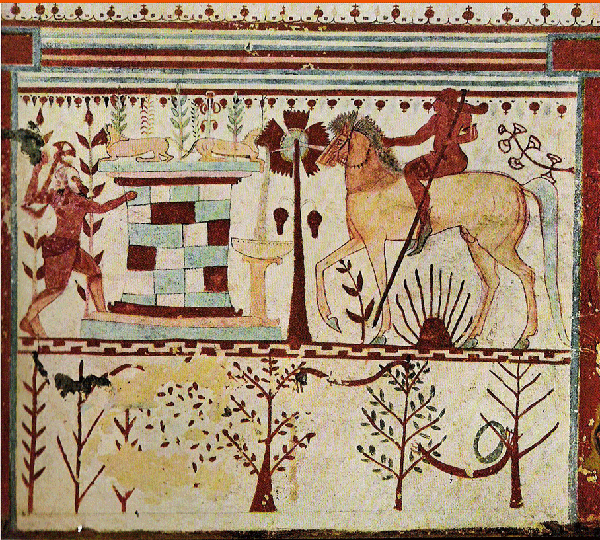All Greek and Etruscan metal rings with engraved bezels ultimately derive from Egyptian and Phoenician cartouche-shaped rings. The cartouche-shaped ring was especially popular in Etruria in the later 500s B.C., where immigrant Greek goldsmiths from Ionia introduced it.
This example features an intricate scene of two men approaching a fountain where water gushes into a vessel from a lion's head spout. Behind the fountain, a man squats as if hiding, holding a sword. These details identify the scene as a standard depiction of the ambush of Troilos (Troilus), prince of Troy, by the Greek hero Achilles during the Trojan War. On this ring, however, a strange dog-headed creature, who is not part of the Troilos myth, sits atop the fountain. The creature may actually be jackal-headed and thus meant to recall the Egyptian god Anubis harking back to the origin of such rings from Egypt.
Prophecies retold in the Iliad link the fate of Troilos, one of the sons of King Priam (or Apollo in some versions of Greek myth), with the fate of Troy itself. Ancient writers including Sophocles treated Troilos, a paragon of youthful male beauty, as the epitome of a dead child mourned by his parents.
Only 54 words have been identified as coming from Sophocles' play, Troilos. Fragment 619 refers to Troilos as an andropais, a man-boy. (A fragment from the 6th century tragic poet Phyrnichus refers to Troilus as possessing the light of love glowing on his reddening cheeks) Fragment 621 indicates that Troilos was going to a spring with a companion to fetch water or to water his horses but a scholion (explanatory comment) to the Iliad states that Sophocles relates how Troilos was ambushed by Achilles while exercising his horses in the Thymbra. Fragment 623 indicates that Achilles mutilated Troilos' corpse by a gruesome method known as maschalismos. This involved preventing the ghost of a murder victim from returning to haunt their killer by cutting off the corpse's extremities and stringing them under its armpits.
Considering Troilos, according to many versions and interpretations, was still a child, Achilles' behavior was beyond the pale. Greek heroes were not always heroic!
 |
| Gold finger ring depicting Achilles' Ambush of Troilos, Etruscan, 550-500 BCE, at the J. Paul Getty Museum, image courtesy of the museum. |
 |
| Roman relief from a statue of Germanicus, 2nd c. CE, depicting the ambush of Troilos, Archeological Museum of Perugia courtesy of Wikimedia Commons contributor Haiduc. |
 |
| Achilles ambushing Troilos and Polyxena, shoulder of an Attic black-figure hydria, 560-550 BCE at the Metropolitan Museum of Art courtesy of Wikimedia Commons contributor Marie-Lan Nguyen. |
 |
| Image: Achilles (left) ambushing Troilus (on horseback, right). Etruscan fresco, Tomb of the Bulls, Tarquinia, 530–520 BCE courtesy of Wikimedia Commons. |

No comments:
Post a Comment